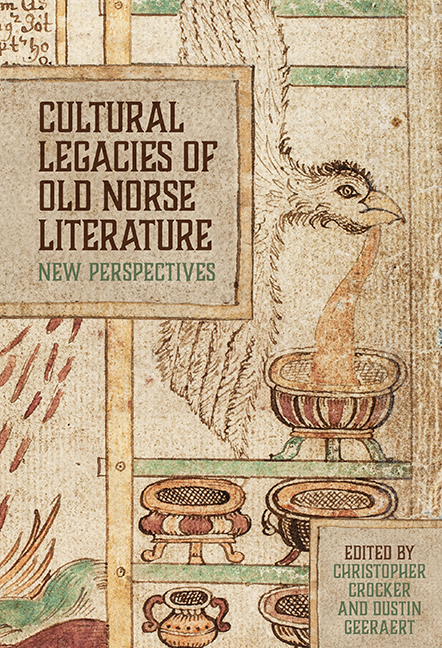Book contents
- Frontmatter
- Contents
- List of Illustrations
- List of Contributors
- Foreword: Old Norse and the Porous Boundaries of Medievalism
- Acknowledgements
- Note on the Text
- Introduction
- 1 Dr Jekyll and Mr Hyde in Medieval Iceland: Saga Realism and the Sworn Brothers
- 2 The Malleability of the Past: Íslendingabók as Narrative History
- 3 Women’s Work and Material Culture in Medieval Iceland: Gender, Narrative, and Cloth Production
- 4 Vafþrúðnismál, from Parchment to Print: Stability and Change in the Transmission of Eddic Poetry
- 5 The Odinic Motif: The Wanderer in the Mist
- 6 What has Darwin to do with Óðinn? Shapeshifting, God, and Nature in the ‘Great Story of the North’
- 7 Madness, Mythology, and Mitteleuropa: Günter Grass’s Transformation of Old Norse Myth in The Tin Drum
- 8 Once More, with Fiction: Transforming Myth in Gerður Kristný’s Blóðhófnir and the Eddic Poem Skírnismál
- Afterword: Ethnographic Medievalisms
- Bibliography
- Index
4 - Vafþrúðnismál, from Parchment to Print: Stability and Change in the Transmission of Eddic Poetry
Published online by Cambridge University Press: 08 October 2022
- Frontmatter
- Contents
- List of Illustrations
- List of Contributors
- Foreword: Old Norse and the Porous Boundaries of Medievalism
- Acknowledgements
- Note on the Text
- Introduction
- 1 Dr Jekyll and Mr Hyde in Medieval Iceland: Saga Realism and the Sworn Brothers
- 2 The Malleability of the Past: Íslendingabók as Narrative History
- 3 Women’s Work and Material Culture in Medieval Iceland: Gender, Narrative, and Cloth Production
- 4 Vafþrúðnismál, from Parchment to Print: Stability and Change in the Transmission of Eddic Poetry
- 5 The Odinic Motif: The Wanderer in the Mist
- 6 What has Darwin to do with Óðinn? Shapeshifting, God, and Nature in the ‘Great Story of the North’
- 7 Madness, Mythology, and Mitteleuropa: Günter Grass’s Transformation of Old Norse Myth in The Tin Drum
- 8 Once More, with Fiction: Transforming Myth in Gerður Kristný’s Blóðhófnir and the Eddic Poem Skírnismál
- Afterword: Ethnographic Medievalisms
- Bibliography
- Index
Summary
The Lay of Vafþrúðnir (Vafþrúðnismál) is a myth, seven-hundred and fifty years old in its oldest manuscript form, and its story tells us about the wisdom contest between the Norse god Óðinn and the Norse giant Vafþrúðnir. Óðinn is victorious over his opponent, and the death of Vafþrúðnir is one of the most important things we know about him, for it marks the climax of the mythic text bearing his name. Also important is his vast knowledge of the cosmos, its past, present, and future, that he imparts to Óðinn and the audience. This important myth is only related in full in this one poem, though fragments of it are found in a few other textual witnesses. Some of the most central stories of Old Norse mythology are presented in the dialogic exchange between the god and the giant. My aim is to explore this myth's rich transmission history in order to highlight the recontextualization process that has occurred with each major change in medium it has gone through. Vafþrúðnismál's textual history begins with skin manuscripts (i.e., parchment or vellum), carries through the early modern paper manuscript tradition in which it has a varied yet stable transmission, and it is now found in many print editions, the most recent Icelandic edition with a full scholarly apparatus dating to 2014, published in the Íslenzk fornrit text series. The present era is another age of transformation for Vafþrúðnismál, as the myth and many narratives like it arrive in the digital age, an arrival marked by the 2019 publication of the facsimile, diplomatic, and normalized texts of the Codex Regius manuscript of eddic poetry in the Editiones Arnamagnæanæ Electronicæ digital texts series.
What follows is thus a tracing of how Vafþrúðnismál has arrived at the present, belonging as it does to a stable narrative tradition that practices careful reproduction of manuscripts and preparation of critical editions. Variation has persisted, however, and adjustments have accompanied each material transition from parchment to paper to print. In modern critical interpretations and artistic creations inspired by the myth, the many Old Norse cosmic myths represented in Vafþrúðnismál continue to find new life and undergo further recontextualization, a process facilitated by the careful hands of scribes, publishers, and translators over the centuries who have made it possible for modern interpreters to read this medieval text and many like it.
- Type
- Chapter
- Information
- Cultural Legacies of Old Norse LiteratureNew Perspectives, pp. 68 - 87Publisher: Boydell & BrewerPrint publication year: 2022



